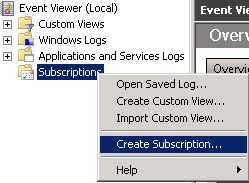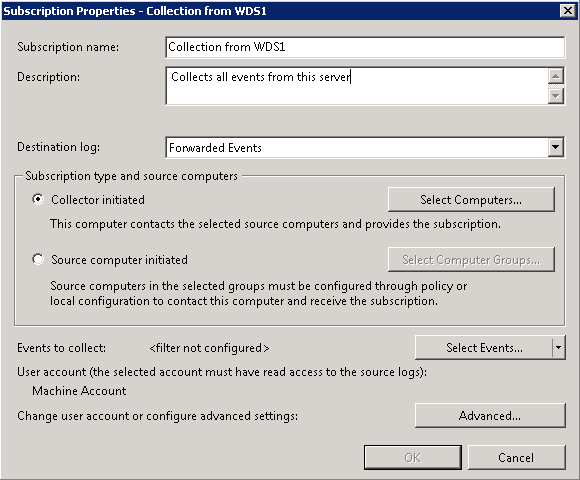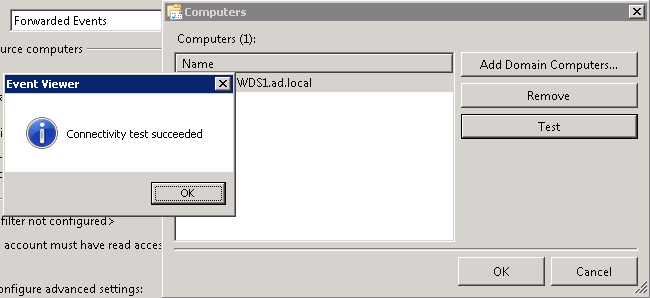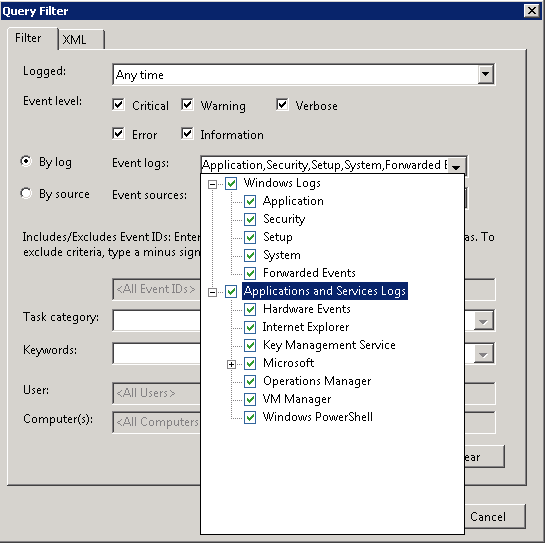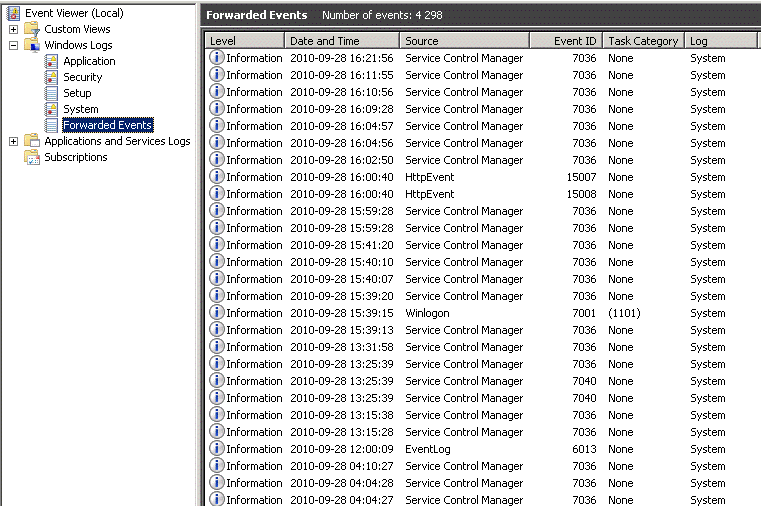- Централизованный Event Log в Windows 2008 Server
- Adam the Automator
- How To Set Up Windows Event Log Forwarding In Windows Server 2016
- Jeff Christman
- Windows Event Log Forwarding Overview
- WEF Project Overview
- Environment and Knowledge Requirements
- Configuring the Event Log Collector
- Enabling WinRM on the Collector
- Starting the Subscription Collector Service
- Setting up the Forwarders’ GPO
- Allowing the Network Service to Read Event Logs
- Setting up a Subscription
- Verifying the WEF Configuration
- Your Takeaways
Централизованный Event Log в Windows 2008 Server
Мне очень понравилась новая возможность по работе с журналами событий в Windows 2008/7/Vista, называемая Event Log forwarding (subscription — или подписка), которая основана на технологии WinRM. Данная функция позволяет вам получить все события со всех журналов с множества серверов без использования сторонних продуктов и настраивается все это в течении всего пары минут. Возможно, именно эта технология позволит вам отказаться от столь любимых многими системными администраторами Kiwi Syslog Viewer и Splunk.
Итак схема такая, у нас есть сервер Windows 2008, запущенный в качестве коллектора логов с одного или нескольких источников. В качестве подготовительной работы нужно выполнить следующие 3 шага:
На коллекторе логов в командной строке с правами администратора запустите следующую команду, которая запустит службу Windows Event Collector Service, измените тип ее запуска в автоматический (Automatically — Delayed Start) и включите канал ForwardedEvents, если он был отключен.
wecutil qc
На каждом из источников нужно активировать WinRM:
winrm quickconfig
По умолчанию сервер-коллектор логов не может просто собирать информацию из журналов событий источников, вам придется добавить учетную запись компьютера-коллектора в локальные администраторы на все сервера-источники логов (в том случае, если сервер-источник работает под управлением 2008 R2, то достаточно добавить учетку коллектора в группу Event Log Readers)
Теперь мы должны создать подписки (Subscriptions) на сервер коллектор. Для чего зайдите на него, откройте консоль MMC Event Viewer, щелкните правой кнопкой мыши по Subscriptions и выберите Create Subscription:
Здесь вы можете выбрать несколько различных настроек.
При каждом добавлении коллектора, неплохо было бы проверить подключение:
Далее вы должны настроить фильтр, указав какие типы событий вы хотите получать (например, Errors и Warnings), также можно собирать события по конкретным номерам Event ID или по словам в описании события. Есть один нюанс: не выбирайте слишком много типов событий в одну подписку, анализировать этот журнал можно будет бесконечно :).
Расширенные настройки (Advanced settings) могут понадобиться, если вы хотите использовать нестандартный порт для WinRM, или захотите работать по протоколу HTTPS, или же оптимизировать сьор логов по медленным каналам WAN.
После нажатия OK подписка будет создана. Здесь вы можете щелкнуть правой кнопкой мыши по подписке и получить статус выполнения (Runtime Status), или перезапустить ее (Retry) если предыдущий запуск был неудачным. Обратите внимание, что даже если ваша подписка имеет зеленый значок, в процедуре сбора логов могут быть ошибки. Поэтому всегда проверяйте Runtime Status.
После начала работы подписки, вы сможете просматривать перенаправленные события. Имейте в виду, что если журналы очень большие, то их первичный сбор может занять некоторое время.
Конфигурацию можно посмотреть на вкладке Properties -> Subscriptions.
В том случае, если сбор логов не работает, сначала на сервере-источнике логов удостоверьтесь, что локальный файрвол настроен корректно и разрешает трафик WinRM.
Один раз, когда я добавил учетную запись сервера-коллектора в группу Event Log Readers, но не добавил ее локальные админы, была такая ошибка;
[WDS1.ad.local] – Error – Last retry time: 2010-09-28 16:46:22. Code (0×5): Windows Event Forward Plugin failed to read events. Next retry time: 2010-09-28 16:51:22.
Я попробовал добавить учетку сервера в группу локальных админов, в результате появилась такая ошибка:
[WDS1.ad.local] – Error – Last retry time: 2010-09-28 16:43:18. Code (0×7A): The data area passed to a system call is too small. Next retry time: 2010-09-28 16:48:18.
Оказывается, я выбрал в фильтре слишком много журналов для сбора. Поправив фильтры так, чтобы они собирали чуть меньше информации, я победил эту ошибку.
Adam the Automator
How To Set Up Windows Event Log Forwarding In Windows Server 2016
Jeff Christman
Read more posts by this author.
Event log management is a critical skill to learn in all Windows environments. Activity is being recorded to Windows event logs every second and it acts as not only a security tool but also as a vital troubleshooting aid.
Once a server environment goes past a few servers though, managing individual server event logs becomes unwieldy at best. Luckily, you have a feature called Windows Event Forwarding (WEF) to make it easier.
Table of Contents
Windows Event Log Forwarding Overview
WEF is a service that allows you to forward events from multiple Windows servers and collect them in one spot. The service has two main components; a forwarder and a collector. A collector is a service running on Windows server that collects all events sent to it from an event log forwarder.
The “link” between the forwarding server and a collector is known as a subscription.
Collectors serve as subscription managers that accept events and allow you to specify which event log alerts to collect from endpoints.
WEF Project Overview
This is a Project article where we cover how to build a project or implement a solution. Each section hereafter will be cumulative steps that build upon the previous.
For this project, you’re going to learn how to set up a basic WEF implementation. You’ll learn how to set up both a collector and how to forward events to a collector with a subscription.
You’ll learn how to:
- Set up and configure an event log collector on a Windows Server instance. This will be the Windows Server that all of the event log forwarders will send events to.
- Create a GPO which, when applied, will point applicable Windows Server instances to the collector to send events to.
- Configuring the types of events to send to the collector.
You will learn how to work through each step in the remainder of this article.
Environment and Knowledge Requirements
Before you get too far, let’s first ensure my environment is the same as yours. Please be sure you have the following items in place before starting:
- (2) Windows Server instances – You can use any Window Server instance of 2012 R2 or higher. In this article, I’ll be using Windows Server 2016.
- Active Directory
- GPO – A familiarity with Group Policy Objects will be required.
- WinRM- WinRM needs to be running on all clients. Not configured just running.
Configuring the Event Log Collector
The first task to perform is configuring one of your Windows Server instances as the collector. Recall that the collector is the one that receives incoming event logs from the forwarder.
Enabling WinRM on the Collector
Windows Server instances that forward events to the collector do so over PowerShell Remoting or WinRM. You’ll first have to ensure WinRM is available on your collector. If the collector is running Windows Server 2012 R2 and above, WinRM is enabled by default, but the Windows Firewall may be interfering.
Run the the Enable-PSRemoting PowerShell cmdlet with no parameters on the collector. Even if PowerShell Remoting is already enabled, it will skip the necessary steps.
To be sure, you can also run Invoke-Command -ComputerName -ScriptBlock <1>from a remote computer. If you don’t receive an error, PowerShell Remoting is working.
Starting the Subscription Collector Service
Now that PowerShell Remoting is enabled and listening, start the subscription collector service. The subscription collector service needs to also start up automatically when Windows Server boots up.
On the collector, open Event Viewer click on Subscriptions. The first time you open the Subscriptions option, Windows will ask if you want to start the Windows Event Log Collector Service and configured to start automatically. Click Yes to accept.
You can see an example of the message below.
Congratulations! You now have a collector configured. It’s now time set up a GPO which will instruct Windows Server instances to forward events to the collector.
Setting up the Forwarders’ GPO
The next step is to configure one or more Windows servers to begin forwarding event logs to the collector. The easiest way to do so is by creating a GPO. This GPO can then be applied to one or more OUs which contain the servers to send events from.
You’ll learn the basics of setting up the necessary settings in a GPO in this Project article. But if you’d like to a complete rundown with all the available options, check out the Microsoft documentation.
Allowing the Network Service to Read Event Logs
WEF uses the Network Service account to read and send events from a forwarder to a collector. By default, the Network Service account does not have access to do this. You’ll first need to set this ACL to allow it.
Note: Many of the event logs in Windows Server already provide the Network Service account access to the common event logs like Application and System. But the account is not given access to the Security event log and other custom event logs.
To allow the Network Service account to read event logs on event log forwarders, use a GPO. In this article, you’ll learn how to allow the Network Service account access to the Security event log. Other event logs will follow the same process.
1. Begin by opening up a command prompt and running wevtutil gl security . This will provide various information about the Security event log. But the piece to pay attention to is the channelAccess SDDL.
You can see below an example of the SDDL you’ll need for the Security event log. The channelAccess line represents the permissions set on the event log. Copy the SDDL highlighted below and save it somewhere for later to add to a GPO.
2. Create a GPO via the Group Policy Management Console. Inside of the GPO, navigate to Computer Configuration → Policies → Administrative Templates → Windows Components → Event Forwarding → Configure target subscription manager.
3. Set the value for the target subscription manager to the WinRM endpoint on the collector. You will set the Server to be in the format:
Note the Refresh interval at the end of the collector endpoint. The Refresh interval indicates how often clients should check in to see if new subscriptions are available.
4. Next, find the SDDL you copied earlier from running wevtutil gl security and paste it into the setting Computer Configuration → Policies → Administrative Templates → Windows Components → Event Log Service → Security → Configure log access.
Note that this SDDL will take precedence over all other permissions that have been configured for the event log.
You can see an example of what your GPO will look like below for the Security event log.
5. Once the GPO is created, you’ll then either link this GPO to an existing OU containing the Windows servers to send event logs from or create a new OU and link the GPO. Any AD computer account you add to this OU will now set up a subscription to the collector.
Setting up a Subscription
While configuring WEF to collect all events for all Windows servers in an Active Directory domain may seem like a good idea, it’s not. You must be selective and only forward events that are important to you. Filtering out the noise from what matters is where WEF demonstrates its true value.
Let’s work through setting up a subscription for the Security Event log.
Since you’ve already created the GPO and linked it to an Active Directory OU containing the Windows servers you’d like to send events from, the event sources are already set up
- On the collector, open the Windows Event Viewer and right-click on Subscriptions, then create subscription.
2. As shown below, select the Source computer initiated option and then click Select Computer Groups. This is where you will select which computers you’d like to forward events from.
Pro Tip: Selecting AD Groups. Ex: “Domain Controllers” will auto-populate any computers within the group. No need to select individual computers every time you add a new server.
3. Next select the events to forward. Opening up the query filter as you can see below, select Security to forward events to the collector from the Security event log.
4. Once the Security log is selected, you can filter down even more by entering the event ID, keywords, users and computers as shown below.
5. Click OK to exit from the Query Filter.
6. Click Advanced in the Subscription Properties window. Now select Minimize Latency. This setting will ensure the collector will receive events as soon as possible and also to help it catch up if it gets behind.
Verifying the WEF Configuration
Once WEF is set up, you should now check to see if the forwarders actually checked in by checking the Source Computers column on the main Subscriptions page.
You can also check the Event Forwarding Plugin Operational log under Applications and Services on the client to make sure everything is working. This is where you’ll see descriptive errors if something has gone awry with Kerberos or firewalls.
All that is left to to is find a low-value client, clear the Security log and see if you get an alert.
Your Takeaways
In this Project, you learned how to set up a basic WEF subscription. You:
- Set up an event collector
- Created a GPO to create a subscription on various Windows Server forwarders
- Configured a WEF subscription to only send specific events
- Ensured the WEF subscription sent events as fast as possible
WEF is a bit tricky to configure initially, but once up and running, you should have little problems and minimal maintenance headaches.
